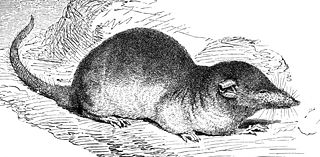
This list contains the species in the order Soricomorpha. Soricomorpha is no longer considered a valid taxon; it is now known to be paraphyletic, since erinaceids are the sister group of shrews. [1] [2] [3]

This list contains the species in the order Soricomorpha. Soricomorpha is no longer considered a valid taxon; it is now known to be paraphyletic, since erinaceids are the sister group of shrews. [1] [2] [3]

Shrews are small mole-like mammals classified in the order Eulipotyphla. True shrews are not to be confused with treeshrews, otter shrews, elephant shrews, West Indies shrews, or marsupial shrews, which belong to different families or orders.

The red-toothed shrews of the subfamily Soricinae are one of three living subfamilies of shrews, along with Crocidurinae and Myosoricinae. In addition, the family contains the extinct subfamilies Limnoecinae, Crocidosoricinae, Allosoricinae and Heterosoricinae. These species are typically found in North America, northern South America, Europe and northern Asia. The enamel of the tips of their teeth is reddish due to iron pigment. The iron deposits serve to harden the enamel and are concentrated in those parts of the teeth most subject to wear.

The white-toothed shrews or Crocidurinae are one of three subfamilies of the shrew family Soricidae.
A unicuspid is a tooth that has only one cusp.